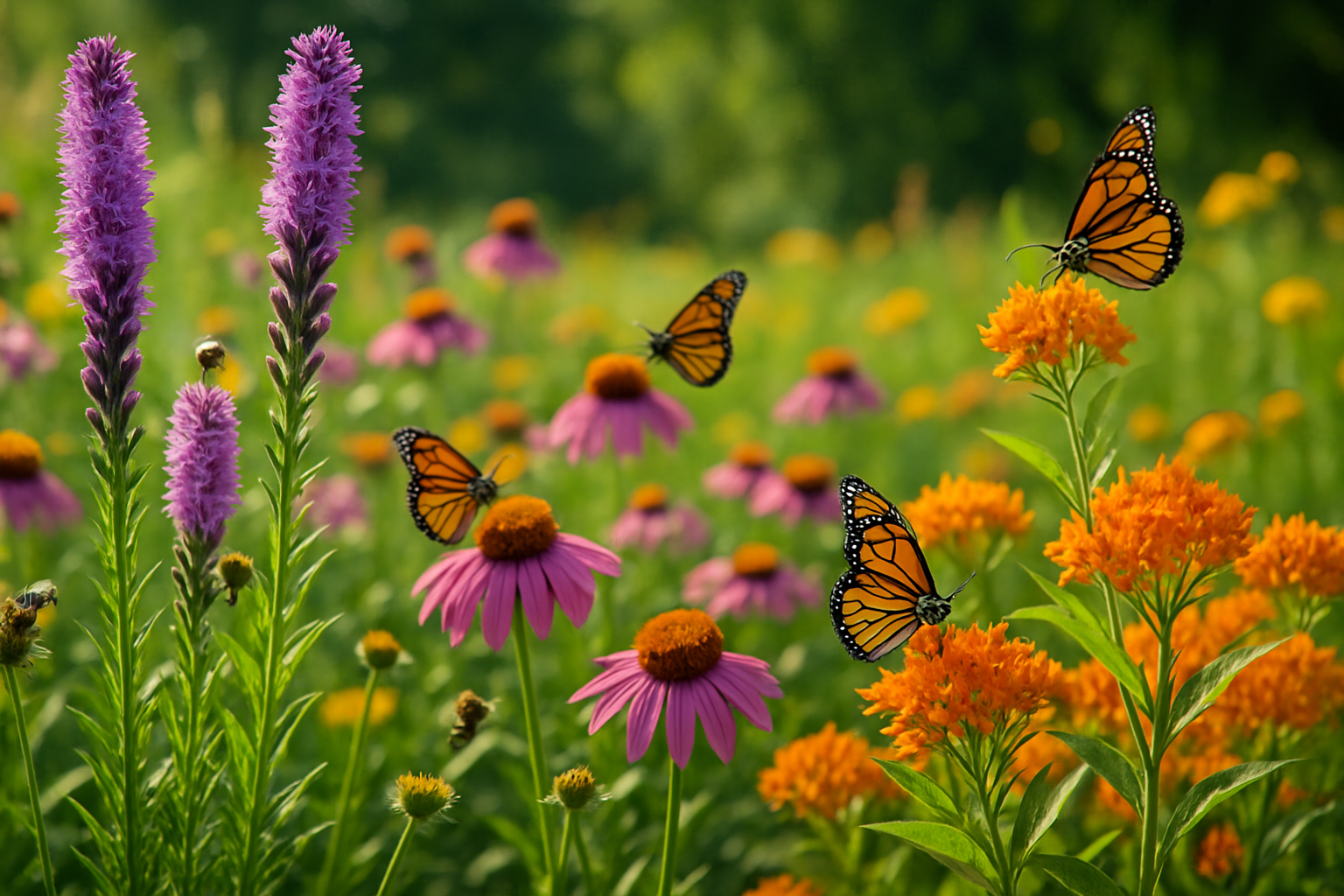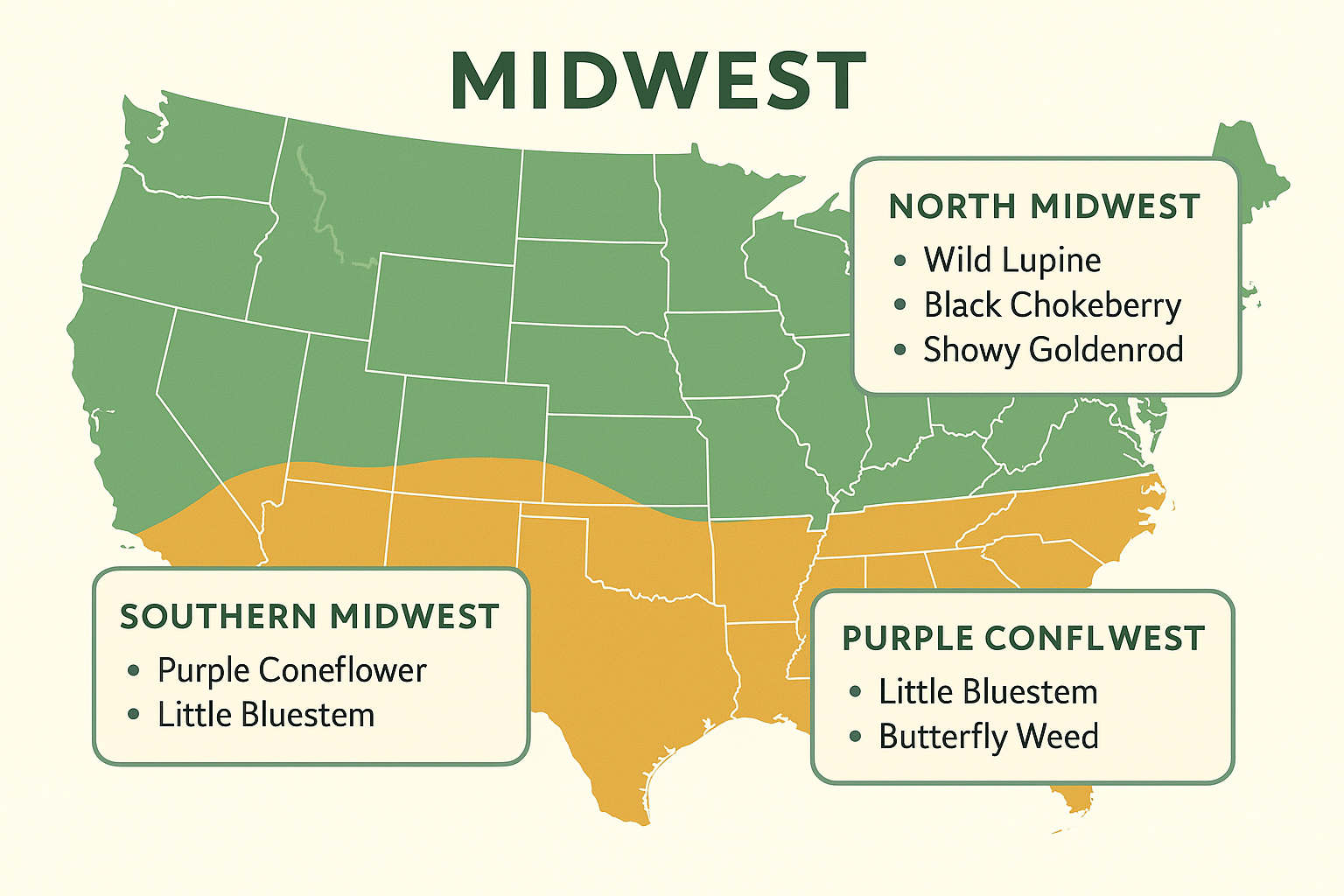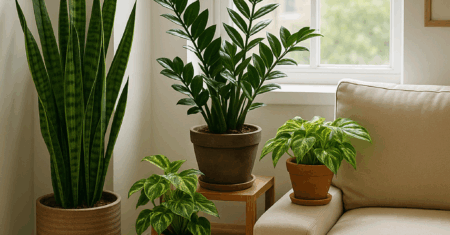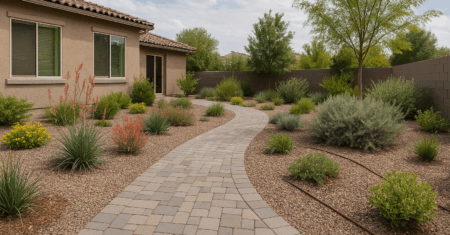Native Plant Gardening by US Region: Best Native Plants for Midwest Gardens

As we explored in our Complete Guide to Sustainable Landscaping, working with local ecosystems rather than against them creates thriving outdoor spaces with minimal effort. Finding the best native plants for Midwest gardens can transform your landscape into a low-maintenance haven that supports local wildlife while reflecting the region’s natural beauty. Many gardeners across Illinois, Indiana, Wisconsin, Michigan, and surrounding states struggle with choosing appropriate native species that will flourish in their specific growing conditions without becoming invasive or requiring constant attention.
This in-depth guide focuses specifically on native Midwestern plant selections that naturally evolved in the region’s unique climate conditions, making them perfectly adapted to local soils, rainfall patterns, and temperature fluctuations while providing essential habitat for native birds, butterflies, and beneficial insects.
What You’ll Discover About Midwest Native Plant Gardening 🌱
For a broader understanding of sustainable gardening practices, check out our Complete Guide to Sustainable Landscaping. This focused guide will help you:
- 🦋 Select regional powerhouse plants – Native species that support maximum wildlife with minimum maintenance
- 🌞 Create year-round interest – Four-season combinations specifically for Midwest climate conditions
- 💧 Reduce water usage – Native alternatives to thirsty ornamentals that thrive naturally in the region
- 🦅 Attract local wildlife – Plants that support native bees, butterflies, birds and beneficial insects
Here we’ll explore how to create a beautiful, resilient Midwest native plant garden that thrives with minimal intervention while maximizing ecological benefits.
Why Midwest Native Plants Deserve Special Attention
The Midwest region’s unique climate and ecological history have created plant communities specifically adapted to its conditions. According to the National Wildlife Federation, native gardens in the Midwest can support up to 14 times more pollinators than conventional landscaping. This is particularly significant as Illinois, Indiana, and Michigan have lost over 90% of their original prairie habitat, making home gardens crucial wildlife corridors.
Midwestern gardeners face distinct challenges: harsh winters with subzero temperatures, hot humid summers, clay-heavy soils, and fluctuating precipitation patterns. Native plants have evolved specifically with these conditions for thousands of years, developing deep root systems and unique adaptations. NativeBackyards.com notes that native flowering plants provide nectar sources for pollinators and produce “berries, nuts, or seeds for birds and small mammals… often timed exactly when the animals need them.”
By focusing on plants native to the Midwest specifically, rather than generalized “native American plants,” you can create a microhabitat that directly supports your local ecosystem. These plants have co-evolved with local wildlife, making them essential food sources for caterpillars, nesting materials for birds, and shelter for beneficial insects – creating ecological relationships that non-native ornamentals simply cannot provide.

🌼 Foundation Species for Midwest Native Gardens
When establishing a Midwest native garden, certain foundation species create the backbone of a successful landscape. These workhorses provide reliable structure, extended bloom periods, and maximum wildlife value across various growing conditions.
Top Native Foundation Plants for Midwest Gardens
| Plant Name | Height | Bloom Time | Wildlife Value | Growing Conditions |
|---|---|---|---|---|
| Purple Coneflower (Echinacea purpurea) | 3-4′ | Jun-Aug | Butterflies, bees, songbirds | Sun/part shade, adaptable to most soils |
| Little Bluestem (Schizachyrium scoparium) | 2-3′ | Aug-Feb (seedheads) | Nesting birds, butterfly hosts | Full sun, tolerates poor soil |
| Wild Bergamot (Monarda fistulosa) | 2-4′ | Jul-Sep | Hummingbirds, bees, butterflies | Sun/part shade, adaptable to most soils |
| Black-Eyed Susan (Rudbeckia hirta) | 1-3′ | Jun-Sep | Pollinators, finches | Full sun, tolerates clay soil |
For clay-heavy soils common throughout much of the Midwest, native plants offer significant advantages. Wild Bergamot (Monarda fistulosa) and New England Aster (Symphyotrichum novae-angliae) have adapted specifically to penetrate and gradually improve dense clay conditions, while providing stunning purple late-summer blooms that attract numerous pollinators.
Pro Tip: When establishing native plants, remember the gardening adage “first year they sleep, second year they creep, third year they leap.” Native perennials invest in root development before significant top growth, requiring patience but resulting in extraordinary drought tolerance and longevity. Consider planting in groups of 3-5 of the same species for visual impact and better pollinator attraction.
Whether you’re in Michigan’s Upper Peninsula or southern Illinois, these foundation species offer adaptability across the region while providing critical ecological services.
🦋 Native Plant Combinations for Maximum Impact
Creating effective combinations of Midwest natives elevates your garden from a collection of plants to a cohesive ecosystem. These strategic pairings ensure continuous blooms, complementary heights, and wildlife support throughout the seasons.
Spring-to-Fall Bloom Sequence Combination
- Early Spring: Wild Columbine (Aquilegia canadensis) + Virginia Bluebells (Mertensia virginica)
- Late Spring: Wild Lupine (Lupinus perennis) + Prairie Phlox (Phlox pilosa)
- Summer: Purple Coneflower (Echinacea purpurea) + Butterfly Weed (Asclepias tuberosa)
- Late Summer/Fall: New England Aster (Symphyotrichum novae-angliae) + Smooth Blue Aster (Symphyotrichum laeve)
Sun-Loving Prairie Combination
- Structural Backdrop: Big Bluestem (Andropogon gerardii) + Indian Grass (Sorghastrum nutans)
- Mid-Layer: Prairie Blazing Star (Liatris pycnostachya) + Rattlesnake Master (Eryngium yuccifolium)
- Foreground: Prairie Dropseed (Sporobolus heterolepis) + Prairie Smoke (Geum triflorum)
“Combinations of native plants can create stunning ‘plant communities’ that not only look beautiful together but also support each other ecologically,” explains Neil Diboll, noted prairie ecologist and founder of Prairie Nursery in Wisconsin. “The best designs mimic natural associations we see in the wild.”
For more comprehensive guidance on sustainable landscaping principles, see our Complete Guide to Sustainable Landscaping which explores how these native plant communities fit into larger ecological design strategies.
💧 Low-Maintenance Strategies for Midwest Native Gardens
The true advantage of Midwest native plants is their ability to thrive with minimal intervention once established. Implementing these specific techniques will help your native garden flourish while reducing maintenance time and resources:
Right-Plant-Right-Place Design Approach
- Match plants to your specific site conditions (soil type, moisture, sun exposure)
- Group plants with similar needs together (prairie species in full sun, woodland species in shade)
- Plan for mature sizes to minimize future division or relocation
- Leave 12-18″ between plants to allow natural growth patterns
Establishment-Phase Watering Schedule
- Week 1-2: Water deeply every other day
- Week 3-4: Water twice weekly
- Month 2-3: Water weekly during dry periods
- After Year 1: Water only during extreme drought (4+ weeks without rain)
Natural Maintenance Calendar for Midwest Natives
| Season | Maintenance Tasks | What to Avoid |
|---|---|---|
| Spring | Cut back previous year’s growth in early spring (March-April), divide spreading plants if needed | Don’t clean up too early – many beneficial insects overwinter in plant debris |
| Summer | Minimal weeding, deadhead only if seed spread is concerning | Avoid supplemental watering of established plants, which creates dependency |
| Fall | Leave seed heads and stalks standing for winter interest and wildlife | Don’t “tidy up” – seed heads feed birds and provide winter interest |
| Winter | Plan next season’s additions, enjoy structure and movement of dormant plants | Don’t apply salt near native plantings |
Kate Halpin, native plant specialist at Midwestern nursery Possibility Place, shares: “For my clients, the ‘aha moment’ comes in year three when they realize they’ve spent almost no time maintaining their native garden while their neighbors are still fighting with fertilizers, frequent watering, and endless mowing. The plants just work because they belong here.”
🌡️ Region-Specific Native Plant Challenges
While Midwest native plants are generally well-adapted to local conditions, specific challenges can arise depending on your exact location within this diverse region. Understanding these variations helps ensure success with your native plant selections.
Northern vs. Southern Midwest Considerations
The climate difference between northern Minnesota and southern Missouri is substantial, affecting which “Midwest natives” will thrive in your specific location:
Northern Midwest (Zones 3-4)
- Choose cold-hardy natives like Pasque Flower (Pulsatilla patens)
- Select shorter varieties that can withstand snow load
- Plant earlier-blooming species to maximize the shorter growing season
- Consider microclimates to protect less hardy species
Southern Midwest (Zones 5-6)
- Incorporate heat-tolerant natives like Aromatic Aster (Symphyotrichum oblongifolium)
- Choose drought-resistant prairie species for summer resilience
- Extend bloom season with late-flowering plants like Goldenrod varieties
- Consider Southern natives that are expanding northward with climate change
Important Note: When selecting native plants, prioritize local ecotypes whenever possible. A plant grown from seed collected within 100 miles of your location will be genetically adapted to your specific growing conditions. Many specialized native plant nurseries offer regionally appropriate ecotypes rather than generic cultivars.
For urban and suburban settings, be aware of municipal regulations that may affect native landscapes. Some communities have outdated ordinances limiting plant height or requiring regular mowing. Organizations like Wild Ones (a native plant advocacy group) provide resources for navigating these challenges and educating neighbors about the ecological benefits of native plantings.
To extend your native plant knowledge beyond the Midwest, explore our related article on Pacific Northwest Native Plant Combinations for insights into another region’s approach to native landscaping.
![midwest-native-plant-regional-map.jpg – Alt text: Map of the Midwest showing growing zones with callout boxes highlighting specific native plant recommendations for northern and southern regions]
Creating Your Midwest Native Plant Garden Plan
Now that you’ve explored the diverse world of Midwest native plants, it’s time to create a personalized plan for your specific location. The most successful native gardens start with thoughtful planning based on your site conditions and goals.
Begin by thoroughly assessing your property’s growing conditions—soil type, sun exposure, moisture patterns, and existing vegetation. This information will guide your plant selections toward species that will naturally thrive in your landscape. Consider focusing first on a smaller “keystone” area where success will be visible and motivating before expanding to larger spaces.
Remember that native plant gardens evolve over time, unlike static traditional landscapes. Initial plantings may shift as some species self-seed, while others naturally form communities. This dynamic quality is part of what makes native gardens both ecologically valuable and perpetually interesting.
For comprehensive guidance on sustainable landscaping principles, including water conservation, soil health, and integrated pest management, visit our Complete Guide to Sustainable Landscaping. There you’ll find broader context for how your native plant choices contribute to larger ecological benefits.
Your next steps should include:
- Documenting your site’s specific growing conditions
- Selecting appropriate native plants for your region and site
- Finding reliable sources for true native species (not cultivars)
- Preparing your planting area properly before installation

Frequently Asked Questions About Midwest Native Plants
🌱 How do I differentiate between true native plants and “nativars” (native cultivars)?
True native plants are propagated from wild seed sources without selective breeding, while nativars are cultivated varieties bred for specific characteristics like compact size or enhanced flower color. Look for scientific names without cultivar designations (e.g., Echinacea purpurea instead of Echinacea ‘PowWow Wild Berry’). While nativars offer some ecological benefits, research from Mt. Cuba Center shows they often support fewer pollinators than their wild counterparts. When possible, choose straight species from nurseries specializing in local ecotypes.
🌿 Which invasive plants are commonly confused with Midwest natives?
Several problematic invasives are frequently mistaken for beneficial natives. Purple loosestrife (Lythrum salicaria) is often confused with native blazing star (Liatris species); Japanese knotweed (Fallopia japonica) with native Joe-Pye weed (Eutrochium purpureum); and Queen Anne’s lace (Daucus carota) with the similar-looking but native Rattlesnake Master (Eryngium yuccifolium). Always verify scientific names when purchasing plants and check your state’s invasive species list before introducing new species to your garden.
🦌 How can I protect my native plant garden from deer?
Deer pressure varies significantly across the Midwest, but several effective strategies include: selecting deer-resistant natives like aromatic aster, rattlesnake master, and wild bergamot; applying repellents consistently, especially on new plantings; using physical barriers like temporary fencing during establishment; interplanting vulnerable species among deer-resistant ones; and using motion-activated deterrents in high-pressure areas. Remember that deer resistance is relative, not absolute—during food scarcity, deer may eat almost anything.
🌊 Which Midwest natives work best for rain gardens and wet areas?
For consistently wet or periodically flooded areas, excellent Midwest natives include: Swamp Milkweed (Asclepias incarnata), Cardinal Flower (Lobelia cardinalis), Blue Flag Iris (Iris versicolor), Fox Sedge (Carex vulpinoidea), Great Blue Lobelia (Lobelia siphilitica), and Joe-Pye Weed (Eutrochium maculatum). These species have adapted to fluctuating moisture levels and can handle both seasonal flooding and occasional dry periods, making them ideal for rain gardens, bioswales, and pond edges.
Resources for Your Midwest Native Plant Journey
Transforming your landscape with regional native plants is a rewarding journey that connects you to the unique natural heritage of the Midwest. To deepen your knowledge and find the resources you need:
Essential Articles on Our Site:
- Complete Guide to Sustainable Landscaping – Our comprehensive overview of eco-friendly landscape practices
- Southeastern US Native Plants for Shade – Explore native options for another region’s challenging conditions
- New England Native Garden Plants: Low Maintenance Options – Compare Midwest plants with those from another region
Find Native Plants Near You:
- Midwest Native Plant Society Directory – Searchable database of specialized nurseries
- Wild Ones Native Plant Finder – Tool that helps find plants native to your exact zip code
What native Midwest plants have you had success with in your specific location? Share your experience in the comments below to help others in your area create thriving native landscapes!




0 Comments